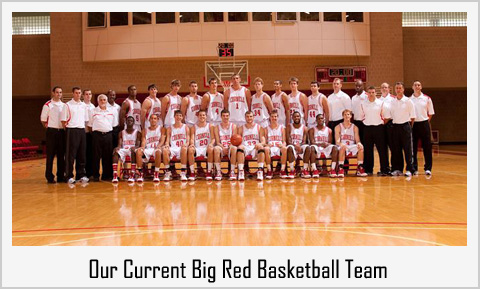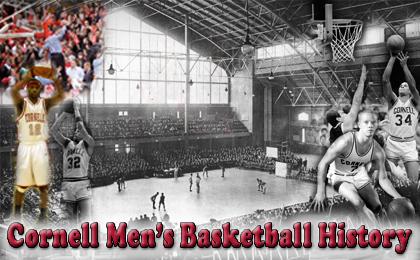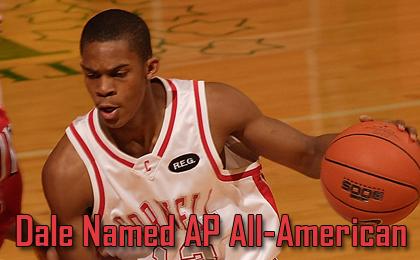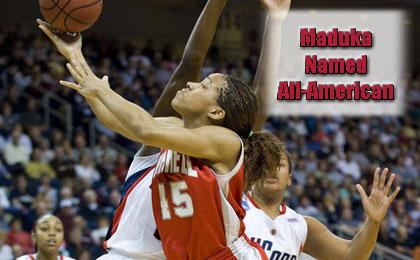
When a Cornellian thinks about varsity sports at our University, thoughts almost invariably turn to ice hockey, football, crew, lacrosse, and perhaps wrestling. A better-kept secret is the tradition of Big Red basketball. If one loves Cornell as we do, and if we are basketball fans generally, then what better synthesis than -- Big Red Basketball!!!
There were some very fine teams during our Cornell years. Indeed, we never had a losing record in the 1961-65 seasons. The coach throughout was Hugh (Sam) McNeil, who went on in later years to serve in the New York State Assembly – an unlikely career progression. The Barton Hall scoreboard operator beginning in our very first year was Hal Kuntz, the proprietor of the popular Hal’s Deli downtown (still in existence today!) We featured all-Ivy players, and even one who was drafted by the New York Knicks upon graduation!
Just as the first football game in fall 1961 was an exciting spectacle, so too was this writer overwhelmed by his first appearance at a basketball game at stately, massive Barton Hall, on January 12, 1962. The season was underway; I had missed three early (non-league) home games in December, and to this day I do not understand why. It was a treat to watch 6-foot-4 senior forward Bill Baugh toss in his jump shots as Cornell overwhelmed Dartmouth, 72-48. The team was in the middle of a 7-game win streak resulting in a 14-2 record. After a road loss to the same Dartmouth team, we got to see back-to-back home wins against traditional powerhouses Princeton and Penn. But with Cornell in the thick of the Ivy race, something happened that was to become standard fare in our years: Our title hopes were dashed right in Barton, as Yale eked out a 48-47 victory. We beat Brown the next night but went down to Princeton and Penn on the road to finish 9-5 in the League, but 18-7 overall. Bill Baugh made the all Ivy first team with an overall 16.6 scoring average, and smooth 6-1 guard Jerry Szachara from nearby Johnson City made the second team.
With that exciting initiation, one could look forward to our sophomore-year team in 1962-63. It was headed by returning guard Szachara and his 6-7 sidekick Jerry Krumbein at center. Szachara was a wonderful shooter and driver; Krumbein had a nice shot from the pivot and despite his stringbean frame was a strong rebounder, earning all-Ivy honorable mention the season before. This season also marked the beginning of varsity eligibility for our own classmates, notably the talented backcourt player Dave Bliss, sturdy forward Marv Van Leeuwen, and reliable center Jim Maglisceau. Once again, Cornell started off with a winning record. One of my favorite games was on December 18, shortly before holiday break, against traditional upstate rival Syracuse. I actually finished writing a paper ahead of time so I could go to the game with a clear schedule. Van Leeuwen had what turned out to be a “career game” with 26 points as the Red beat the Orange, 93-77. That night was also noteworthy in that our freshman team rallied to beat the Syracuse freshmen: That Orange team featured an incredibly acrobatic player named Dave Bing, who went on to a phenomenal career in the NBA.
Soon after, our record soured, but we were revived by wins in January at Barton against Penn, 78-76, and Princeton, 73-67. These games were notable for the leaders of the opposition, both who became Rhodes Scholars: Penn’s John Wideman went on to a distinguished writing career; and Princeton’s Bill Bradley, already a basketball phenomenon, later played for the Knicks, served in the U.S. Senate from New Jersey, and sought the Democratic nomination for President in 1992. Bradley was incredible – I remember him sinking a long baseline hook shot during warm-ups, and saying to myself that he would never do that in an actual game. After the game started, he made just such a shot, and scored 37 points, including 21-for-21 from the foul line. Except possibly for Bing given his ultimate pro success, Bradley was indisputably the greatest player we ever saw at Barton Hall in those years.
Alas, we were not to win a championship in this season either. And once again, the last hopes were dashed by Yale at Barton, again on February 23, and again by one point – this time in overtime, 61-60. Szachara’s heroics and 26 points almost pulled us through but not quite. We finished with a 12-12 record, 6-7 in the league (one game with Columbia was postponed and never played). Szachara, or “Szach” as we called him, finished with an 18.0 scoring average and made the all-Ivy first team – and he was the player drafted by the Knicks. Krumbein made second team for his efforts, and our own Marv Van Leeuwen attained honorable mention.
If the team of the first two years was paced by Cornellians above us in class, the next two featured a group of players who came after we did. The core of the fabulous freshman team that overcame Dave Bing became the core of the varsity for the period 1963-66. Starters from that group at various times included another “stringbean” 6-7 center, Steve Cram; freshman forwards Gary Munson and Bob McCready; guard Bob DeLuca; and swingman Bob Berube. The 1963-64 team was led at least spiritually by senior guard Ray Ratkowski, of whom it could be said that he gave 110% on the court, with tenacious defense, daring layups and dives for loose balls. And what a season opening – vs. New York University, led by Barry Kramer and future NBA star Happy Hairston, and ranked #2 in the nation in pre-season polls. The Barton crowd thrilled as our fledgling team rushed to a 32-23 lead in the first half. Cram showed himself to be quite agile under the basket. NYU proved too strong, however, and prevailed 82-65; but it was a promise of things to come for this rejuvenated Big Red team. We won 4 of the next 5, and this writer got to see the Cornell team at the Holiday Festival tournament during Christmas week 1963 at Madison Square Garden, where it fought gamely but succumbed to a strong Minnesota team, featuring future pros Lou Hudson and Archie Clark, by a respectable score of 89-77. When Princeton and Penn made their visit, the Red was 7-4. Unfortunately, we saw Bill Bradley at his best, scoring 37 of his 49 points in the second half as the Tigers roared to an 87-82 win. The Red rebounded to pound Penn, 85-70. The rest of the season was exciting, including a loss at home to Dave Bing’s Syracuse team, 89-85. The oddity of that game was that at least half the Barton crowd seemed to have been Orange rooters. They had come down from Syracuse to watch the Muhammad Ali – Sonny Liston fight on Ithaca’s cable TV system later that night. When all was said and done, Cornell finished 9-5 in the league and 15-9 overall. Cram made all-Ivy second team with a team-leading 12.6 average, and Berube and Ratkowski earned honorable mention.
As enjoyable as the first 3 seasons were, nothing could match the excitement generated in our senior-year season (1964-65). The core of the team was now in its junior year, augmented by our classmates, floor leader Bliss, team captain Van Leeuwen and center Maglisceau. This team was to set school scoring records. Cram would set up in a low post and score with agility, forward Munson would be in a high post from where he could screen for others and launch his own shots; DeLuca would pop bombs from the outside or score on layups; and Bliss would prove more than ever to be a fine jump-shooter and playmaker. The team took 4 of its first 5 contests, losing only by 2 points to a highly-touted Colorado State team which visited Barton. After a loss to Connecticut, the Big Red embarked on a streak never seen before in Cornell basketball history. The team won 15 straight games, to reach a record of 11-0 in the Ivy League and 19-2 overall.
Highlighting this skein was what was perhaps for me the greatest game ever witnessed in any sport anywhere, and certainly in Ithaca. On January 16, 1965, the Princeton Tigers came into town with Bill Bradley greater than ever, for an Ivy league-lead showdown. I got to the game with my roommates at 6:35 p.m., even though it was supposed to start about 8:10, to make sure we got seats. We had to settle for space on the aisle steps. The attendance that night, over 9000, easily exceeded the permissible fire-law limits.. And what a game the overflow crowd got to witness. Cornell raced to an early lead, as much as 50-33, as Bradley was off target and the rest of the Tigers pretended to play a team game. But then the fireworks started. Bradley regained his shooting form, made one impossible basket after another, and with under a minute left, Princeton led by 69-68. That is when an improbable hero emerged. By this time, small sophomore guard Blaine Aston was in the lineup, spectacles and all. On the last offensive play for Cornell, he received a pass around the foul line. I wondered to myself what the team was doing passing to him, when he calmly launched a 15-foot one-hander that “tickled the twine” for a final 70-69 lead with 3 seconds left. One last-gasp shot by Princeton was unsuccessful, and Cornell had its greatest basketball victory. Bradley was “held” to 38 points. Barton went wild.
Cornell finished this season at 11-3 in the League and 19-5 overall. For their efforts, Steve Cram and Bob DeLuca, both with 15.5 scoring averages, earned first-team Ivy honors; and the steady Bliss, second team.
Our direct Cornell basketball experience had come to an end. But this 1965 graduate has continued to follow the program with love and devotion through the years. Some highlights have included seeing the Cram-DeLuca group at Columbia in my first year as an alumnus; thrilling to news of Greg Morris leading Cornell with 37 points, to a 92-77 victory over the Kentucky Wildcats, and the Red upsetting #3 Princeton 62-56, in 1966-67; visiting Barton during Christmas 1977 for an invitational tournament that included my Dad’s undergraduate alma mater, CCNY; taking my sons in the 80s to see fine teams at Barton led by the likes of center Ken Bantum (another Knick draftee) and all-time Cornell scorer John Bajusz; seeing the talented 1987-88 team several times and being at Princeton with my sons when Cornell clinched the Ivy title in 1988, then to proceed to the NCAA for the second time ever; seeing the 1992-3 team with Jeff Gaca and Zeke Marshall upset #19 California at the Meadowlands in New Jersey, 74-54 (admittedly, Cal star Jason Kidd was out injured); and witnessing exciting games in our modern Newman Arena, with family and friends, in recent years during the turnaround of the program under Coach Steve Donahue.
That brings us to the present period: The 2007-08 season was arguably the best in Cornell basketball history. The men’s team "ran the table" on its Ivy opponents, finishing 14-0 in the League and 22-5 overall in the regular
opponents, finishing 14-0 in the League and 22-5 overall in the regular

To make the season even better, Coach Dayna Smith’s Big Red women’s team ALSO won the Ivy title. This made for the first time any Ivy school copped both men’s and women’s hoop titles in a single season.
The Cornell women finished 12-3 in the League, including a tie-breaking playoff win over Dartmouth, and 20-9 overall – the best season in the program’s history. They were led by superathlete and forward Jeomi Meduka, who simultaneously competed at the All-American level in track. Meduka matched Dale’s accomplishments in being chosen as Ivy Player of the Year and an Honorable Mention All-American. Senior forward Moina Snyder and sophomore guard Lauren Benson were named Honorable Mention All-Ivy. As with the men, a defeat in the NCAA tournament, this one to perennial powerhouse Connecticut, could not offset the achievements of this tenacious team.
Connecticut, could not offset the achievements of this tenacious team.
Then in the 2008-09 season, the men repeated their championship accomplishment, going 11-3 in the Ivies and 21-10 overall. I enjoyed a visit to Ithaca to see the Red run roughshod over Harvard, 96-75, following with a different kind of thriller the next night, a double overtime win, 79-76, over Dartmouth. The team performed credibly against a powerful Missouri team in the opening round of the NCAA, staying within 4 points in the first half before succumbing. Wittman and Dale made first team all-Ivy, Foote second team; and guard Chris Wroblewski was chosen as Ivy rookie of the year.
In the 2009-10 season, the Red are expected to repeat as Ivy champions, although we should get a good run from an excellent Harvard team. Ryan Wittman is on his way to surpassing John Bajusz as the all-time top scorer at Cornell. By late December, the team had raced to a 9-2 record, including a win over Massachusetts, the alma mater of two of my sons, which I personally witnessed up in Amherst; and a championship in the Holiday Festival Tournament at Madison Square Garden. In that tournament, my sons and I got to see Cornell win an overtime victory, 91-88, on a buzzer-beating 3-pointer by Wittman; and an upset over host St. John’s, 71-66. Jeff Foote was chosen tourney MVP. The remainder of the demanding schedule includes a trip to play #1 Kansas on January 6. Hopefully by March, we can report a third consecutive Ivy men’s title and another trip to the NCAA tournament!
Cornell basketball is a tradition worth honoring and preserving.